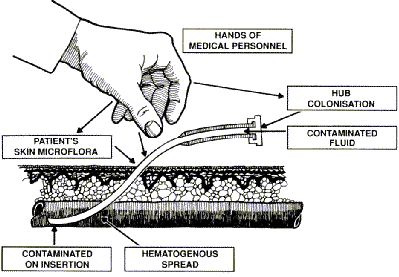|
About Prevention of Catheter-related Infections
|
Strict adherence to
hand washing and aseptic technique remains the cornerstone of prevention of catheter-related infections. However, other measures may confer additional protection and must be considered when formulating preventive strategies. These measures include the selection of an appropriate site of catheter insertion and type of catheter material, use of barrier precautions during catheter insertion, replacement of catheters, administration sets, and IV fluids at appropriate intervals, appropriate catheter-site care, and the use of filters, flush solutions, prophylactic antimicrobials, and newer intravascular devices (e.g., impregnated catheters, needleless infusion systems). |
|

|
Intravenous administration set replacement. The optimal interval for routine replacement of IV administration sets has been examined in three well-controlled studies. Data from each of these studies show that replacing administration sets 72 hours or more after initiation of use not only is safe but cost-beneficial.
However, certain fluids (i.e., blood, blood products, and lipid emulsions) are more likely than other parenteral fluids to support microbial growth if
contaminated and more frequent replacement of IV tubing may be required when such fluids are administered. Stopcocks, used for injection of medications, administration of IV infusions, or collection of blood samples, may represent another portal of entry for microorganisms into vascular catheters or IV fluids.
(Ref: http://www.phppo.cdc.gov/cdcrecommends/showarticle.asp)
|
|

